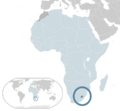Click here to register!
Difference between revisions of "Lesotho Energy Situation"
***** (***** | *****) |
***** (***** | *****) |
||
| Line 36: | Line 36: | ||
= Policy Framework, Laws and Regulations<br/> = | = Policy Framework, Laws and Regulations<br/> = | ||
| + | |||
= Institutional Set up in the Energy Sector<br/> = | = Institutional Set up in the Energy Sector<br/> = | ||
Revision as of 12:29, 26 August 2016
Capital:
Maseru
Region:
Coordinates:
29.0000° S, 28.0000° E
Total Area (km²): It includes a country's total area, including areas under inland bodies of water and some coastal waterways.
30,360
Population: It is based on the de facto definition of population, which counts all residents regardless of legal status or citizenship--except for refugees not permanently settled in the country of asylum, who are generally considered part of the population of their country of origin.
2,305,825 (2022)
Rural Population (% of total population): It refers to people living in rural areas as defined by national statistical offices. It is calculated as the difference between total population and urban population.
70 (2022)
GDP (current US$): It is the sum of gross value added by all resident producers in the economy plus any product taxes and minus any subsidies not included in the value of the products. It is calculated without making deductions for depreciation of fabricated assets or for depletion and degradation of natural resources.
2,236,502,124 (2022)
GDP Per Capita (current US$): It is gross domestic product divided by midyear population
969.94 (2022)
Access to Electricity (% of population): It is the percentage of population with access to electricity.
50.38 (2021)
Energy Imports Net (% of energy use): It is estimated as energy use less production, both measured in oil equivalents. A negative value indicates that the country is a net exporter. Energy use refers to use of primary energy before transformation to other end-use fuels, which is equal to indigenous production plus imports and stock changes, minus exports and fuels supplied to ships and aircraft engaged in international transport.
no data
Fossil Fuel Energy Consumption (% of total): It comprises coal, oil, petroleum, and natural gas products.
0.00 (2007)
Introduction
The Kingdom of Lesotho is an enclaved, landlock country in southern Africa completely surrounded by South Africa. It is just over 30,000 km2 (11,583 sq mi) in size and has a population slightly over two million.Its capital and largest city is Maseru.[1]
Energy Situation
Renewable Energy
Fossil Fuel
Key Problems of the Energy Sector
Key challenges in the energy sector[2]
- Very low access to electricity. Only 6% of rural households are connected to the national grid.
- Stagnant generation capacity in the last decade and problems in the maintenance of facilities contrasts with rising demand, 6% annual average for period 2003-2010.
- Import dependency from Mozambique and South Africa.
- Weak policy and institutional framework lacking holistic approach and incentives for private sector involvement.
- Low awareness on renewable energy technologies and limited knowledge of potential resources.
Policy Framework, Laws and Regulations
Institutional Set up in the Energy Sector
Ministry of Natural Resources or Ministry of Energy, Meteorology and Water Affairs
Acording to SE4ALL report for Lesotho, The Ministry of Natural Resources through the Department of Energy is responsible for the overall administration and coordination of energy in Lesotho. Other relevant institutions and entities responding to the Department of Energy include the Petroleum Fund (PF), Lesotho Electricity Company (LEC), Lesotho Electricity Authority (LEA), Appropriate Technology Services (ATS), Lesotho Electrification Unit (LEU), National Rural Electrification Fund (NREF) to be established and Lesotho Electricity Generation Authority (LEGA). However, the Energy Policy 2015-2025 does not mention the Ministry of Natural Resources and refers instead to the Ministry of Energy, Meteorology and Water Affairs. This could mean that there has been a change in the names of the Ministries in the recent times.
Institutional overview Energy Sector in Lesotho
|
Department of Energy |
Policy, Plans, Strategy, Programs formulation, enforcement and information dissemination. |
|
Petroleum Fund |
Funding viable energy projects and research and development in the petroleum sector |
|
Lesotho Electricity Authority |
Electricity Sector Regulation |
|
Lesotho Electricity Generation Authority |
Development and management of electricity generation projects to supply Lesotho and the region with electricity |
|
Lesotho Electricity Company |
Electricity transmission, distribution and supply in urban and financially viable areas of the country. |
|
Lesotho Electrification Unit |
Build operate and Transfer of electricity transmission, distribution and supply network and management of NREF |
|
National Rural electrification Fund |
Rural electrification –NREF is still at concept level. |
|
Appropriate Technology Services |
Technology development |
Lesotho Electricity Authority (LEA)
From August, 2004 until April, 2013 the Authority was mandated with regulating the electricity sector. In 2007 the Government decided that the Lesotho Electricity Authority (LEA) should be transformed to be a multi-sector regulatory body assuming additional powers to regulate urban water and sewerage services in the country. LEWA officially started regulating both electricity and urban water and sewerage services sector on May, 2013. The Authority independently deals with matters such as electricity pricing, complaints handling and resolution and the supervision of the implementation of the Quality of Service and Supply standards (QOSSS) by its licensees.
There are other Ministries or agencies with overarching influence over the energy sector: Ministry of Development Planning; Ministry of Finance; Ministry of Mining; Ministry of Public Works and Transport; Water Commission; and Lesotho Revenue Authority.
Further Information
References
- ↑ https://en.wikipedia.org/wiki/Lesotho
- ↑ Rapid Assessment and Gap Analysis for Lesotho SustainableEnergy for All (SE4All)





















